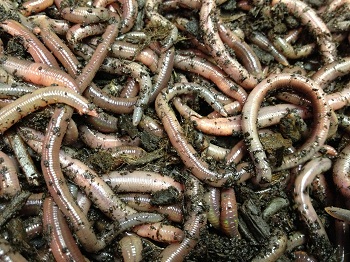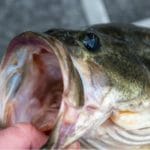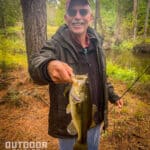Few baits are as iconic as worms. They grace the hooks of a wide variety of anglers, including cane-pole-wielding kids trying to catch catfish at the local creek and grown adults trying to catch perch while shivering atop a frozen lake.
They are even used by anglers trolling for walleye or trying to catch largemouth bass in weed-choked ponds.
And while no bait works 100% of the time, worms are certainly one of the best options to try in most freshwater fishing situations.
But, to get the best results, you’ll need to select the right worms for your target species and the conditions, store them properly to keep them lively and fresh, and then use the right kind of tackle to tempt the local fish into biting.
We’ll discuss these things and more below, so you can maximize the value these awesome baits provide and catch more (and bigger) fish.
Species Selection: What’s on the Menu?
All worms are not created equally, and some work better in some circumstances than others (incidentally, many of the things anglers call “worms” are not technically worms, but that’s not important for our purposes here).
If you want the best chance of success, you’ll need to select the right worm for the occasion. Some of the most popular types of worms include the following:
Nightcrawlers
The big boy of bait worms, the nightcrawler is perhaps the most popular worm used by anglers. Nightcrawler packaged for sale as bait are usually quite large and brown to gray in color.
Because of their size, they generally elicit the attention of larger gamefish, such as bass, catfish and walleyes, and you’ll need a fairly large hook to support their bulk.
Some anglers use nightcrawlers to catch panfish or trout, but it is typically necessary to use only a small piece of a nightcrawler when doing so, as intact nightcrawlers are generally to large and intimidating for fish with small mouths.
Red Wigglers
Named for their color and habit of writhing about incessantly, red wigglers are the worm of choice for those fishing for panfish or trout.
Red wigglers (which are also called red worms or composting worms) are often farmed for use in vermiculture, so they can occasionally be obtained in bulk from non-traditional retail routes.
Red wigglers can vary a bit in size, so large individuals are occasionally effective for catching bass.
Mealworms
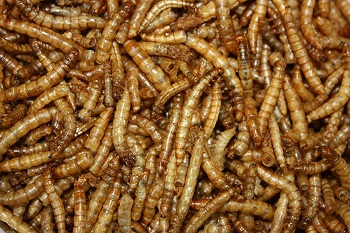
Mealworms are typically used to catch small-mouthed fish, such as panfish and trout, but they’ll elicit attention from small bass at times.
While most mealworms packaged for use as bait have reached their maximum size, you can often find smaller mealworms packaged for sale as food for lizards and other types of small pets.
Waxworms
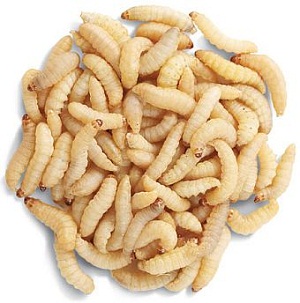
Waxworms have a high fat content, which makes them especially appealing bait for many fish. Waxworms are rather short, but they have plump little bodies, and they are typically used to catch panfish.
Leeches
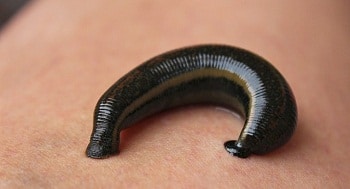
Leeches can be obtained in a variety of sizes, although fairly large ones are most common, so they are typically used to catch walleye, bass and catfish.
Storing Your Worms: Keep Them Fresh while You Fish
You can occasionally catch fish with dead or dried worms, but you’ll find that live, wiggling worms are much more appealing to gamefish. Fresh, live worms will not only attract the attention of fish visually, they’ll also disperse more scent into the water too.
Accordingly, you’ll want to keep your worms as fresh and lively as possible. Fortunately, it isn’t very hard to do so, and you can often keep a cup full of worms alive for several different fishing trips if you are careful.
The most important things to do are to keep the worms cool and appropriately moist. Ideally, you’d have access to a small refrigerator or cooler in which you could keep the worms while you are fishing, but this isn’t always the case.
If this isn’t possible, just keep the worms refrigerated until the last possible moment, and then keep them in the coolest, shadiest place you can.
It is also important to keep the dirt in the worm cup moist, to prevent the worms from drying out (note that this is not appropriate for mealworms and wax worms, which are typically packaged in grains or wood shavings – they should be kept dry).
The easiest way to keep the worms from drying out is to simply keep the top securely attached at all times.
If you notice that the dirt is drying out a bit, you can add a few drops of water to the cup. Just avoid oversaturating the soil, as this will force the worms to the surface and will eventually cause them to die.
Baiting the Hook: Preparing an Appetizing Offering
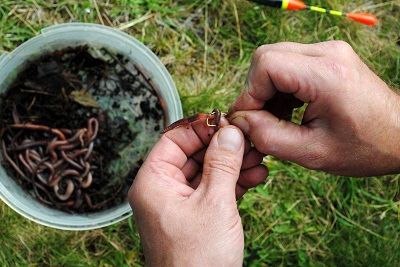
Monofilament or fluorocarbon line in the 4- to 6-pound-test range is ideal for panfish and trout, but you’ll need to use 6- to 10-pound-test to catch big bass, catfish or walleyes.
There are a variety of different hook styles you can use for worms, but circle hooks and traditional bait-keeper hooks (which often have metal tabs that will keep the bait in place) are the two most popular choices.
Circle hooks are often very effective for catching panfish and other species which tend to nibble, rather than inhale, baits. Bait-keeper hooks are a better choice when catching bass or walleye with nightcrawlers or big red wigglers.
Hook size selection is as much of an art as it is a science, but the following sizes will give you a good starting point:
- Nightcrawlers: #2 to 2/0
- Red Wigglers: #12 to #4
- Mealworms: #12 to #6
- Waxworms: #12 to #6
- Leeches: #2 to 1/0
– Nightcrawlers are best hooked through the middle (wacky style) when fishing for bass or catfish, but they are better hooked through the head when fishing for walleye.
– Hook red wigglers by threading them on the hook several times and leaving an inch or two dangling from the end (nightcrawlers can also be hooked in this manner if you are targeting panfish).
– Mealworms and wax worms are best hooked by threading them on the hook from front to back, and only allowing the tip of the hook to protrude.
– Leeches should be hooked through the suction cup to keep them alive and make them look natural.
In addition to using suitable fishing line and hooks, you’ll want to use a good rig for your bait, and it is imperative that you use one that will present the bait where your target fish are lurking.
For example, if you are fishing for bluegill or other panfish, you’ll want to keep the worm fairly high in the water column, where these types of fish hang out.
Conversely, you’ll want to keep the bait near the bottom if you are fishing for catfish or walleye. A float-based rig is a good choice in the former case, while a sinker rig will be the better choice in the latter case.
Float Rigs
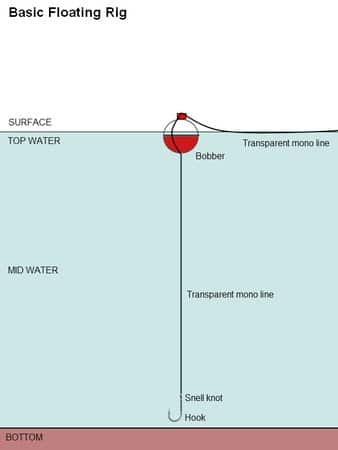
Clamp a few pieces of split shot between the hook and the float to keep the rig stable, and you are ready to go.
However, this type of simple float rig is only practical when the fish are only a foot or two beneath the surface. It isn’t easy to cast and control a 5-, 10- or 15-foot-long leader, so you’ll need to use a slip float rig instead.
A slip float rig relies on a hollow-core float, through which the line can pass.
You’ll put a stopper near the point at which you want the float to stop, which will allow you to reel in most of your line to cast, yet it will allow the worm to sink down to the desired depth before the float stops sliding up the line.
Sinker Rigs
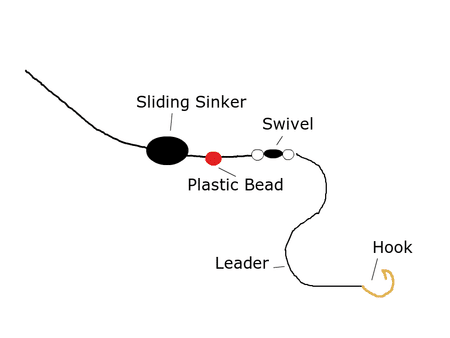
You can set up a simple sinker rig much like you’d set up a simple float rig.
Just select a sinker large enough to keep the bait on the bottom (a ¼-ounce sinker is generally sufficient for shallow water that is only a few feet deep, but you may need a ½- to 1-ounce sinker to get the bait on the bottom in deep water).
Tie the sinker on the line about 2 feet from a bait hook, which you’ve attached to the end of the line.
While such simple sinker rigs can be effective, some fish will spit out the bait when they feel the resistance the sinker imparts on the line.
To avoid this problem, use a slip-sinker rig, which will let the line flow freely once the fish takes the bait. You can rig a slip sinker the same way you would a slip float, but you’ll want to use a swivel rather than a rubber stopper between the bait and the sinker.
Final Thoughts
Worms are a very effective fish bait, and they aren’t hard to find or use. Most bait shops (and some big box retailers) carry a few different varieties, which gives you the chance to experiment and find the best option on a given day.
What types of worms do you like to use when fishing? We’d love to hear about your preferences. Tell us your “go to” worm for various fishing situations and be sure to share any special tips you may have.


